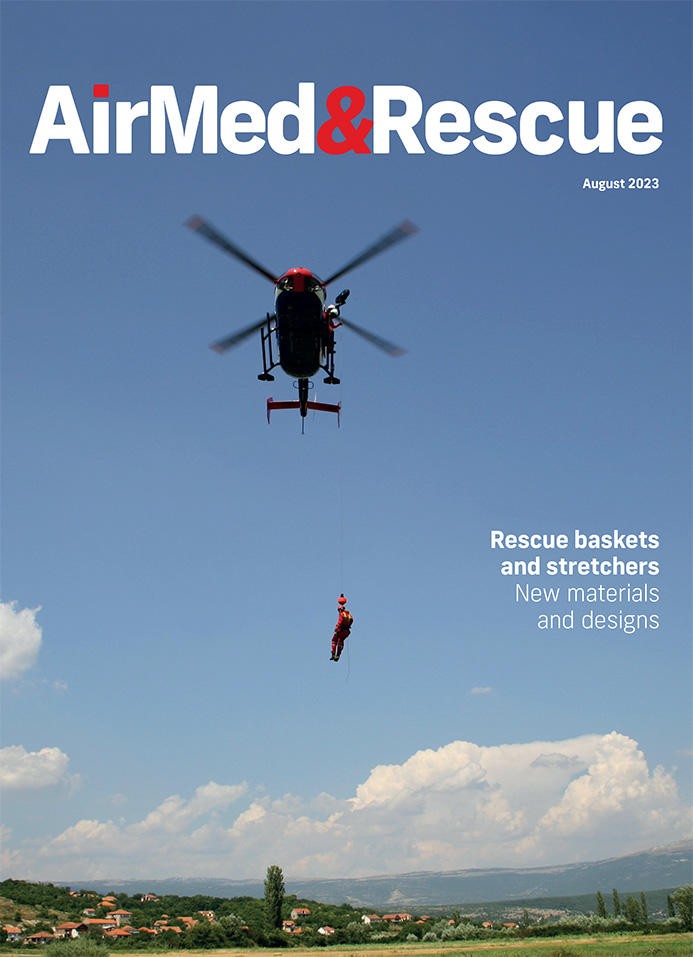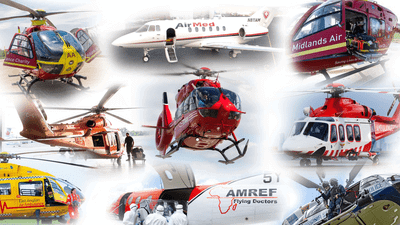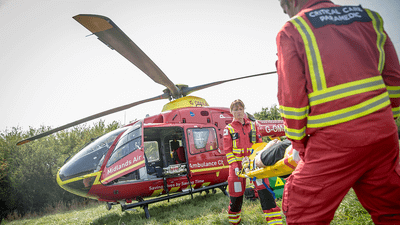Interview: Michael Cooke, CEO of Avcair and OneOneAir

Australian air ambulance legacy – Michael Cooke tells Jon Adams why his air ambulance service is so meaningful to him
You come from a long line of aviators and medics, is that what got you interested in flying?
My lineage as a fourth-generation pilot – my great-grandfather held Australia’s 11th aviation license – has undoubtedly influenced my passion for flying. My personal interest in flying not only stems from my family’s aviation legacy but also from the profound impact that aviation and medicine has had on my life as a whole.
My grandfather, Rolla Cooke, died flying a Spitfire in World War II a month before my father was born. My father, David Cooke, formerly with the Royal Flying Doctor Service (RFDS), is still a practicing general practitioner (GP) at the age of 81 years. Dad is still busy flying his own aircraft across regional New South Wales (NSW) to support GP services and still seems to have no intention of retiring. My brother Anthony is also a fellow aviator, and is the Head of Flying Operations for Avcair.
With such a unique family connection across aviation and medicine, I have witnessed first-hand the transformative power of aviation in providing critical medical care and saving lives. My company-owned Learjets have now flown in excess of 2,000 air medical hours across both the international and domestic markets. This experience and ongoing dedication to this combined industry make it a privilege to continue such a uniquely blended lineage of aviation and medicine. I think, and I hope, this will keep me busy for a long time to come.
You and your brother started Avcair (formerly known as Coastwings Australia) in 2001 as an air charter business, what prompted you to expand further into the air ambulance sector with OneOneAir?
Coastwings Australia was initially created to offer a solution and service to the private aviation industry, often referred to as VIP charter. In 2018, I procured a Learjet 60, which is a highly capable VIP aircraft. What particularly attracted me to this type of aircraft was also its ability to reconfigure very easily to an air medical aircraft. By virtue of this dual application, I was able to offer the Learjet to both the VIP and also the air medical market.
Having introduced the Learjet to both markets, it soon became very obvious that the air medical demand was very strong. With harnessing careful relationships with medical companies, who provide inflight clinicians, the first year of operating the Learjet predominantly and comprehensively was that of air medical services, rather than VIP. This has remained the primary Learjet offering. Success in this has led to additional Learjet procurements and an expanded Avcair air medical model, where we now operate from three bases, including Singapore and Brisbane. Avcair now also hold long-term air medical contracts across oil, gas and mining, as well as government.
With the success of our air medical ventures, we have now rebranded this specific air medical service offering as OneOneAir. ‘OneOne’ denoting the 11th pilot license in Australia being attained by my great-grandfather, Lionel Cooke.
Through the expansion into the air ambulance sector, we strive to honor the legacy of my family and contribute to the wellbeing of communities by delivering exceptional medical transportation services. The combination of our aviation expertise and the profound understanding of the importance of timely medical care has allowed us to make a tangible impact in saving lives and providing critical care when every second counts.
Through the expansion into the air ambulance sector, we strive to honor the legacy of my family and contribute to the wellbeing of communities by delivering exceptional medical transportation services
What sort of medical missions and services does OneOneAir cover?
OneOneAir covers a wide range of missions and services in the air ambulance sector, collaborating with carefully selected and accredited clinical service teams to ensure the highest quality of care. It is a comprehensive suite of aviation and clinical services, tailored to meet the unique needs of each mission.
Our flights are equipped to handle various specialized cases, including neonatal and pediatric intensive care, bariatric patients weighing up to 160kg, extracorporeal membrane oxygenation (ECMO) patients, and intensive care patients. These capabilities enable us to transport patients with diverse medical conditions, providing them with the critical care they require during transit.
When it comes to the wellbeing of our patients, we leave nothing to chance. Every air ambulance mission is staffed by our specialized and experienced medical team, comprising highly skilled physicians and flight nurses. They bring a wealth of knowledge and expertise to each flight, ensuring that every patient receives the highest level of care and attention throughout the entire journey.
What aircraft does OneOneAir use in their fleet, and why have you chosen it?
Our fleet consists of aircraft carefully selected and configured to meet the demands of air medical missions. We understand the importance of speed, reliability, and the ability to reach even the most remote locations efficiently. Our flagship aircraft, the Bombardier Learjet 60, embodies these qualities and more. With its exceptional performance capabilities, including impressive speed and range, the Learjet 60 allows us to swiftly transport patients while providing a comfortable and stable environment for medical care during transit. It is this attention to detail and our commitment to aircraft excellence that sets us apart in the air ambulance sector.
Our team consists of experienced pilots who are well-versed in air medical operations, specialized flight nurses and/or emergency physicians with extensive training in critical care
What is the makeup of your air ambulance crew?
The air ambulance crew at OneOneAir is composed of highly skilled professionals who bring together expertise in aviation and healthcare. Our team consists of experienced pilots who are well-versed in air medical operations, specialized flight nurses and/or emergency physicians with extensive training in critical care, depending on the specific needs of each mission. This multidisciplinary approach allows us to provide comprehensive medical support throughout the entire transport process, ensuring the highest standard of care for our patients.
Do you actively pilot for these special missions?
As the CEO of Avcair and OneOneAir, my primary responsibility lies in overseeing the operations of our air ambulance services. While I am deeply involved in managing the organization and ensuring its smooth functioning, I am also a qualified pilot, and a training and checking captain. On special missions or under certain circumstances, I do actively pilot the aircraft, demonstrating my commitment to being hands-on and in delivering exceptional care to our patients.
Our aircraft are equipped with advanced medical equipment and technology to meet the unique needs of air ambulance operations
How are these aircraft configured and what equipment do you carry as standard?
The aircraft at OneOneAir are meticulously configured to provide a safe and comfortable environment for medical care. Our aircraft are equipped with advanced medical equipment and technology to meet the unique needs of air ambulance operations. This includes life support systems, patient monitoring devices, specialized stretcher systems, and dedicated areas on board for medical personnel to administer care. Each of our Learjet 60s has dual spectrum stretcher capability. We prioritize the seamless integration of medical equipment within the aircraft, ensuring that we can provide efficient and effective medical interventions during air ambulance missions.
Which exceptional situations do you manage that require specialized equipment?
At OneOneAir, we maintain a range of specialized equipment to handle exceptional cases that require advanced medical interventions. This includes equipment for neonatal and pediatric care, advanced cardiac monitoring and resuscitation devices, ventilators, and other specialized devices for respiratory support. By having these tools readily available, we can promptly respond to unique medical needs and provide comprehensive care to patients with complex conditions.
How do your crew stay current with their professional training and education?
Continuous training and education allows our crew to stay up to date with the latest protocols, best practices, and advancements in the field of air medical services, ensuring that we deliver the highest quality care to our patients
The professional training and education of our crew members are of utmost importance to us. We prioritize their ongoing development to ensure they remain current and proficient in their skills. Our crew members undergo regular training, including simulation training through Flight Safety in the USA twice a year, medical training programs, and industry-specific courses. This continuous training and education allows our crew to stay up to date with the latest protocols, best practices, and advancements in the field of air medical services, ensuring that we deliver the highest quality care to our patients.
Are there any planned expansions of services or changes ahead for you or OneOneAir?
As an organization committed to excellence and continuous improvement, we constantly evaluate opportunities for expansion and enhancement of our services. We have recently launched a base in Singapore as part of our global expansion strategy. While I cannot disclose specific details at this time, we are actively exploring potential partnerships, technological advancements, and strategic initiatives that can further elevate our ability to serve patients in need. Our goal is to remain at the forefront of the air ambulance sector, meeting the evolving demands of healthcare and ensuring that we continue to provide aviation excellence to those who rely on our services.

August 2023
Issue
We have a wonderful edition, covering aerial ECMO provision; hoisting and the lessons to be learned; the benefits of fixed-wing air ambulances; preparation for fire seasons; progress towards sustainable aviation fuel; and the variety rescue baskets; plus more of our regular content.
Jon Adams
Jon is the Senior Editor of AirMed&Rescue. He was previously Editor for Clinical Medicine and Future Healthcare Journal at the Royal College of Physicians before coming to AirMed&Rescue in November 2022. His favorite helicopter is the Army Air Corps Lynx that he saw his father fly while growing up on Army bases.

